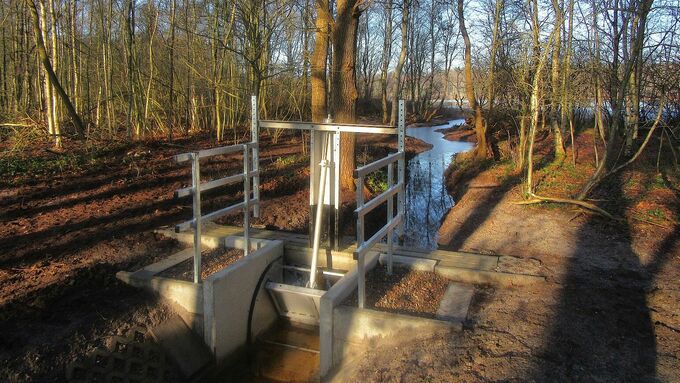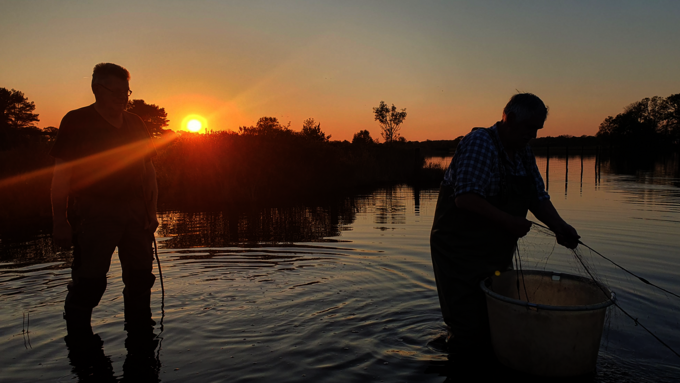New adjustable weir © Paul Müller, Lower Nature Conservation Authority of the District of Cuxhaven
download picturemain content
Project of the month
#01/2024 OPTIMIZATION OF HABITAT TYPE 3110
With concept and perseverance: optimization of the nutrient-poor ‘Silbersee’ in the district of Cuxhaven
The Silbersee, a very special lake at the edge of the Geest with nutrient-poor water and remarkable plant communities, can be found to the east of Bremerhaven in the district of Cuxhaven. Until recently, a relatively stable population of the shoreweed (Littorella uniflora) and small populations of the lake quillwort (Isoetes lacustris) grew here. Unfortunately, the latter could no longer be registered lastly; it survives thanks to a conservation breeding programme at the University of Oldenburg. Efforts have been underway for several years to reintroduce the Dortmann's cardinalflower (Lobelia dortmanna) which used to grow here. Until the middle of the last century, the area around the lake which had been formed by the ice age some 130,000 years ago was dominated by open heathland with nutrient-poor grassland and raised bogs. In the meantime, the surrounding agriculture has taken on a more intensive character. However, a small, near-natural raised bog has been preserved to the west of the lake.
On closer inspection, it became clear that without intervention, this special habitat would be lost. Together with the Lower Nature Conservation Authority of the district of Cuxhaven, the LIFE IP team initially commissioned a specialised research institute to develop a well-founded restoration concept for the sensitive Silbersee. To this end, the researchers took water and sediment samples and analysed the near-surface and deeper groundwater and nutrient inflows as well as other site conditions. The current use of the lake (fishing and bathing) was also analysed.
The restoration concept identified a number of negative factors influencing the target vegetation. These include:
- Increased phosphorus and sulphur concentrations,
- nitrogen input,
- reduced groundwater supply,
- oxygen deficiency in the sediment of the shallow water zone,
- burrowing activity of fish in the shallow water zone.
The restoration concept outlined a timetable for the implementation of measures. In the first phase, so-called no-regret measures were to be implemented which could be realised in the short term without further investigations.
Firstly, a company removed trees and shrubs from the western littoral zones so that the wind can blow across the lake again and mix the water well. The eastern littoral zones were also cleared. The woodland works also aimed at reducing leaf fall into the Silbersee and thus minimise nitrogen inputs. A newly installed, adjustable weir at the open drain now ensures that the water level in the Silbersee can be adjusted optimally at all times.
Dabbling fish species were suspected of ploughing through the shallow water areas which are the potential growth habitat of shoreweed, Dortmann's cardinalflower and lake quillwort, thus influencing their germination and growth conditions negatively. Volunteers from the ‘Diving for Nature Conservation’ project literally got to the bottom of this suspicion and were recruited to carry out underwater mapping of the lake. The photos of the bottom of the lake made it possible to document the negative effects of the fish's burrowing activities on the plant communities. For this reason, the fishes were subsequently removed in consultation with the local fishing club and transferred to another waterbody.
On an area of around 0.27 hectares in the shallow water area of the lake, the aquatic plants were removed along with the rhizomes so that the exposed sandy soil now offers better germination conditions for the target species. A sediment barrier was also used as a linear barrier in the littoral zone to prevent too much sediment from being washed into an existing shoreweed population during the process. An explosive ordnance exploration had also been necessary beforehand, as there had been indications of old m unitions deposits. Fortunately, this was not confirmed.
Following the implementation of the no-regret measures, the action for the LIFE IP team is now complete for the time being. Further monitoring by the University of Oldenburg, the nature conservation diving team and the lower nature conservation authority and NLWKN will show whether further steps will be necessary in the future to stabilise the habitat type 3110. For example, an extension of buffer strips in neighbouring agricultural areas, deep aeration of the lake to reduce the phosphorus concentration or, in the last instance, the addition of phosphorus-binding substances would be possible.
Verwandte Themen
- Habitat type 3110 – Oligotrophic waters containing very few minerals of sandy plains (Littorelletalia uniflorae) (in German)
- Overall objectives of the project
Weitere Links
- NABU Federal Technical Committee ‘Lebendige Seen’ – diving for conservation (in German) (external link opens in a new window)
- Implementation notes for habitat type 3110 - Niedersächsischer Landesbetrieb für Wasserwirtschaft, Küsten- und Naturschutz (in German) (external link opens in a new window)
- District of Cuxhaven - nature and landscape conservation (in German) (external link opens in a new window)
- SAC 023 Silbersee, Laaschmoor, Bülter See, Bülter Moor – Niedersächsischer Landesbetrieb für Wasserwirtschaft, Küsten- und Naturschutz (in German) (external link opens in a new window)
- Nature reserve ‘Silbersee und Laaschmoor’ - Niedersächsischer Landesbetrieb für Wasserwirtschaft, Küsten- und Naturschutz (in German) (external link opens in a new window)





